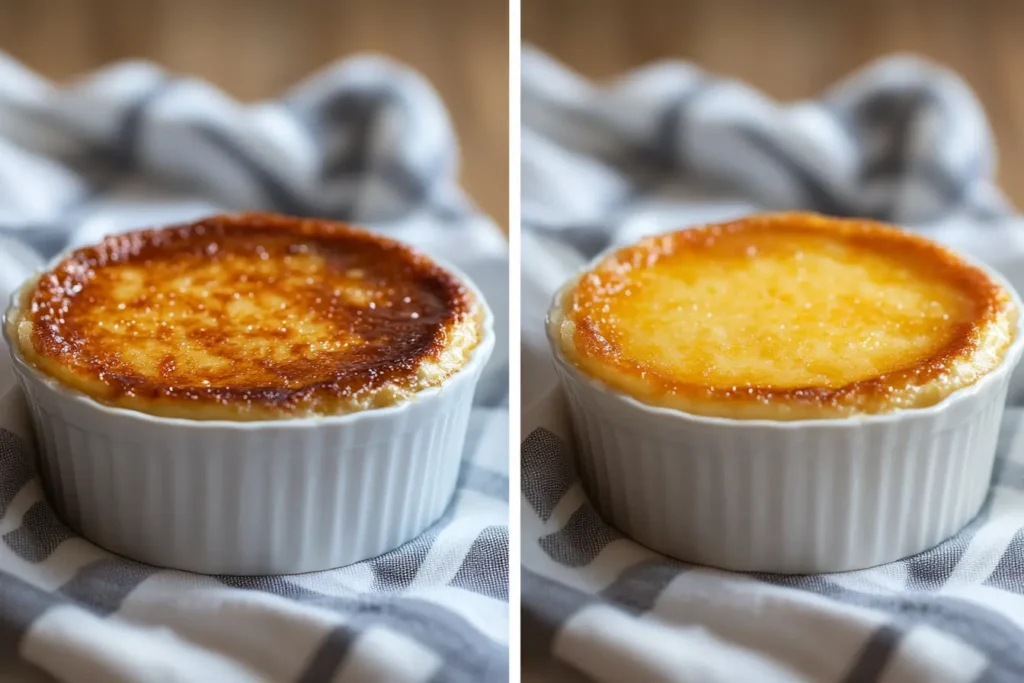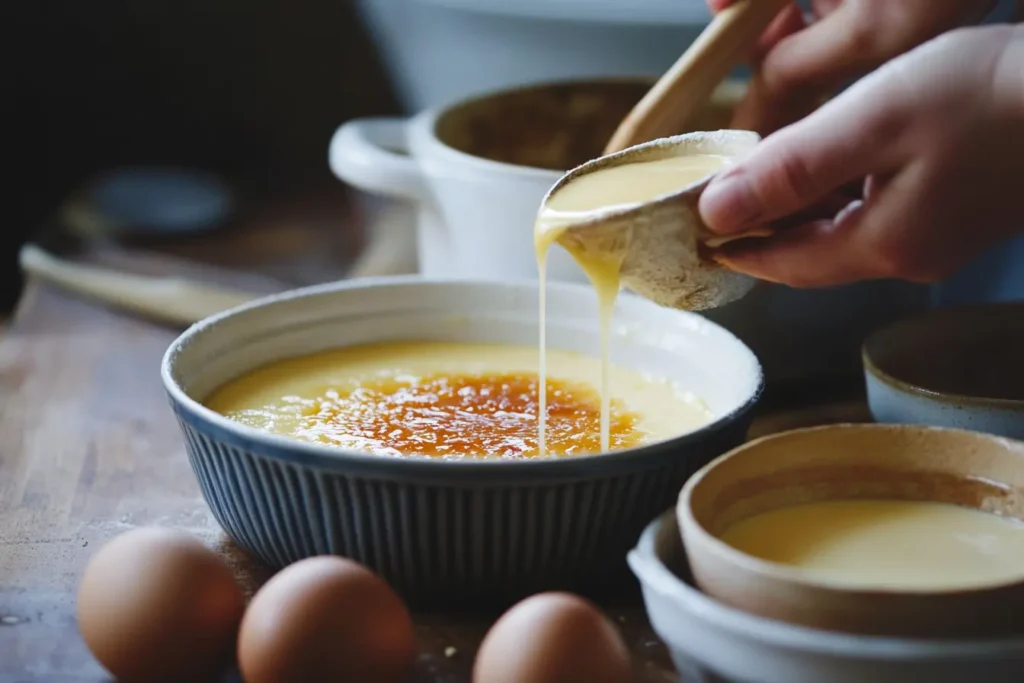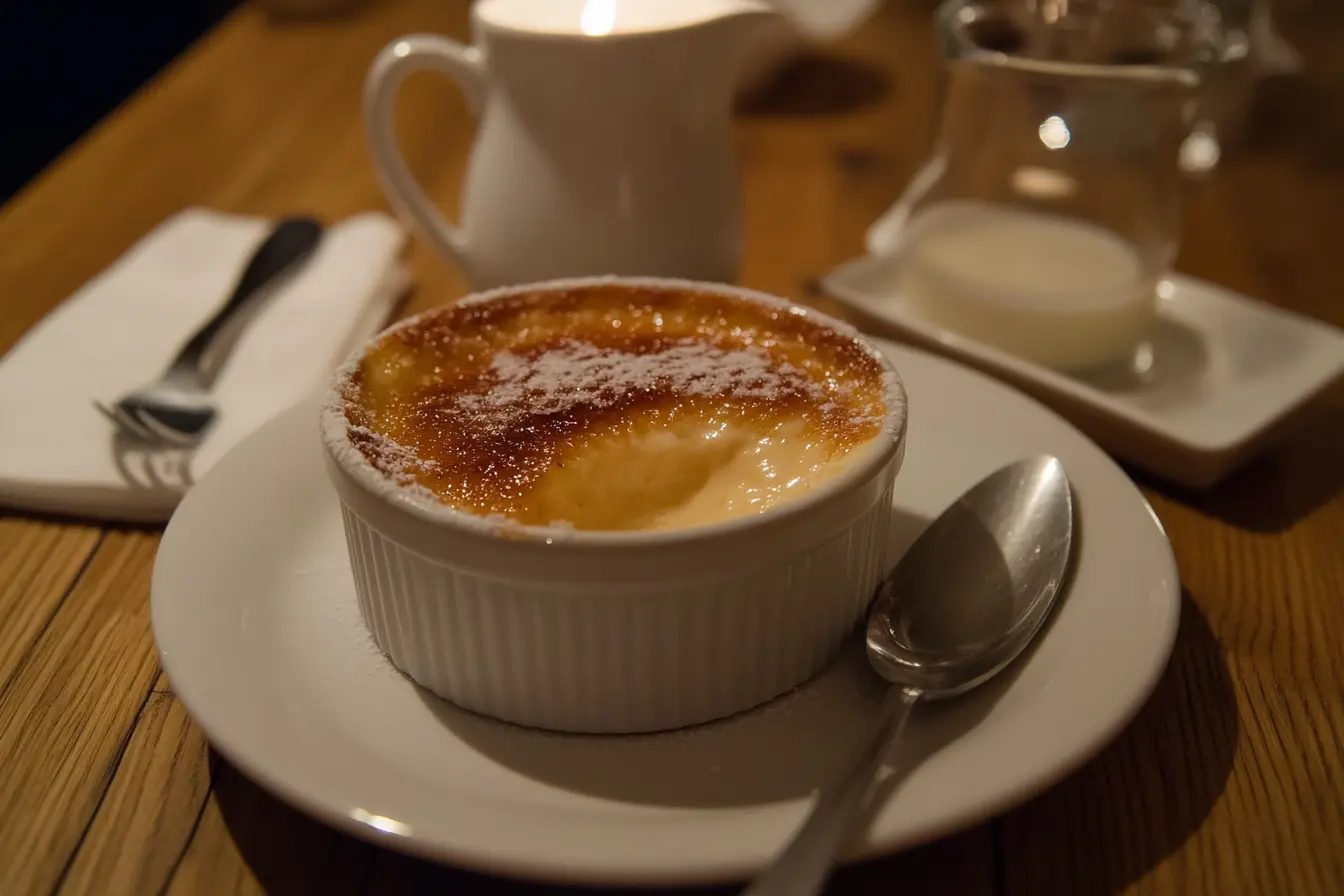Can you use milk instead of heavy cream in crème brûlée? If you’ve ever wanted to make this classic French dessert but found yourself without heavy cream, you’re not alone! Many home bakers wonder if they can swap milk for heavy cream without ruining the texture and richness of their custard.
In this guide, we’ll cover:
- The role of heavy cream in crème brûlée and what happens when you substitute milk.
- The best alternatives if you don’t have heavy cream.
- A step-by-step recipe for making crème brûlée with milk.
- The taste and texture differences between traditional and milk-based crème brûlée.
Let’s dive into the science behind this delicious dessert and find out if milk is a worthy substitute for heavy cream!
Understanding the Role of Heavy Cream in Crème Brûlée
Why Is Heavy Cream Used in Traditional Crème Brûlée?
Classic crème brûlée is known for its rich, velvety custard and crisp caramelized sugar topping. The secret behind its signature texture lies in the fat content of heavy cream.
- Heavy cream contains at least 36% milk fat, making the custard smooth, thick, and luxurious.
- The high fat content prevents curdling, ensuring the custard sets properly.
- Cream gives crème brûlée a rich, indulgent mouthfeel that milk alone can’t replicate.
Without heavy cream, the custard might turn out too thin, watery, or grainy—but that doesn’t mean milk can’t work with some adjustments!
What Happens If You Replace Heavy Cream with Milk?
So, can you use milk instead of heavy cream in crème brûlée? Yes, but there are some important things to consider:
- Milk has a much lower fat content (whole milk has about 3.5% fat), which means the custard will be lighter and less creamy.
- Without enough fat, the texture may be thinner or slightly eggy rather than silky smooth.
- The flavor won’t be as rich, since heavy cream adds depth and decadence.
To make milk work, you’ll need modifications, such as adding butter or using evaporated milk to compensate for the missing fat.
Using Milk Instead of Heavy Cream – Is It Possible?
Can You Use Whole Milk Instead of Heavy Cream?
If you’ve ever run out of heavy cream while making crème brûlée, you may wonder, can you use milk instead of heavy cream in crème brûlée? The short answer is yes, but with some modifications.
Whole milk contains only about 3.5% fat, compared to the 36% fat in heavy cream. This significant difference means:
- The custard will be much lighter and may not have the same rich, velvety texture.
- The fat in heavy cream helps prevent curdling, so using milk requires extra care while baking.
- Without enough fat, the final dish may taste slightly eggy, rather than luxuriously creamy.
While whole milk can work, it’s not a one-to-one substitute. To keep the smooth texture, you may need additional ingredients to make up for the missing fat.
Best Substitutes for Heavy Cream in Crème Brûlée
If you don’t have heavy cream, here are some alternatives that help preserve the texture and richness of the dessert:
- Whole Milk + Butter: Adding melted butter to whole milk increases the fat content, making the custard more similar to one made with cream.
- Evaporated Milk: This concentrated milk is thicker and creamier than regular milk, making it a good one-to-one substitute.
- Half-and-Half: A blend of milk and cream, this option maintains the richness while being lighter than heavy cream.
Each substitute has its own effect on flavor and consistency, so experiment to find the best option for your taste preferences.

How to Make Crème Brûlée with Milk
Step-by-Step Recipe for Milk-Based Crème Brûlée
Now that we know can you use milk instead of heavy cream in crème brûlée, let’s walk through a modified recipe to help maintain the signature creamy texture.
Ingredients:
- 2 cups whole milk (or evaporated milk for better texture)
- 4 large egg yolks
- ½ cup granulated sugar
- 1 teaspoon pure vanilla extract
- ¼ teaspoon salt
- ¼ cup melted unsalted butter (if using whole milk)
- ¼ cup sugar (for caramelized topping)
Instructions:
- Preheat the oven to 325°F (163°C).
- In a saucepan, warm the milk over low heat until slightly steaming. Do not boil.
- In a separate bowl, whisk the egg yolks and sugar until pale and creamy.
- Slowly pour the warm milk into the egg mixture, whisking constantly to prevent scrambling.
- Stir in the vanilla extract and salt.
- Pour the mixture into ramekins and place them in a baking dish.
- Fill the baking dish with hot water halfway up the sides of the ramekins (a water bath helps prevent curdling).
- Bake for 35-40 minutes, or until the custard is set but slightly jiggly in the center.
- Chill for at least 3 hours before caramelizing the top.
- Sprinkle sugar evenly over the custard and caramelize with a kitchen torch or broiler.
Tips for Achieving a Creamy Texture Without Heavy Cream
Since can you use milk instead of heavy cream in crème brûlée is a common concern, here are a few tricks to maintain that silky consistency:
- Use high-fat milk (like whole milk or evaporated milk) instead of skim or 2% milk.
- Incorporate butter to replace some of the missing fat.
- Bake slowly and at a lower temperature to prevent the eggs from curdling.
- Always use a water bath to keep the custard from overheating.
By following these adjustments, you can still enjoy a delicious, creamy crème brûlée, even without heavy cream!
Taste and Texture Differences
If you’re wondering, can you use milk instead of heavy cream in crème brûlée, you might also be curious about how it affects the taste and texture. Traditional crème brûlée is known for its rich, silky custard and crisp caramelized sugar topping, but replacing heavy cream with milk changes some key characteristics.
Does Milk-Based Crème Brûlée Taste the Same?
While milk can be used as a substitute for heavy cream, the flavor profile will be noticeably different:
- Lighter and less rich – Heavy cream gives crème brûlée its signature buttery richness, while milk makes it more delicate and less indulgent.
- Slightly eggier – Since milk has less fat, the egg flavor becomes more pronounced, which can alter the traditional taste.
- Mild sweetness – The natural sweetness of heavy cream is missing, so you may need to adjust the sugar content to compensate.
If you prefer a lighter dessert or want to cut back on fat, a milk-based crème brûlée can still be delicious—just with a less decadent mouthfeel.
How to Prevent a Watery or Curdled Custard
One of the biggest concerns when using milk instead of heavy cream in crème brûlée is the risk of a runny or curdled texture. Since heavy cream helps stabilize the custard, milk-only versions require extra care:
- Use whole milk or evaporated milk – Low-fat or skim milk will make the custard too thin.
- Incorporate a thickener – Adding a small amount of cornstarch or an extra egg yolk can help create a smoother texture.
- Bake at a low temperature – Cooking at 325°F (163°C) or lower ensures the eggs set slowly and evenly.
- Always use a water bath – A bain-marie (hot water bath) prevents overheating and curdling.
By following these small adjustments, you can achieve a custard that’s still creamy and set properly, even without heavy cream.
FAQs – What People Also Ask
If you’re still unsure about making this substitution, here are answers to some of the most common questions regarding can you use milk instead of heavy cream in crème brûlée?
Can You Make Crème Brûlée with Low-Fat Milk?
Technically, yes, but it’s not recommended. Since crème brûlée depends on fat for creaminess and stability, using low-fat milk (like 2% or skim) will result in a thin, watery custard. If you must use low-fat milk, try:
- Adding a tablespoon of cornstarch to help thicken the mixture.
- Mixing in a bit of melted butter for extra fat content.
Is There a Dairy-Free Alternative to Heavy Cream?
Yes! If you’re looking for a non-dairy option, you can replace heavy cream with:
- Full-fat coconut milk – The best substitute, offering richness and a slight coconut flavor.
- Cashew cream – Blended cashews and water create a smooth, creamy alternative.
- Almond milk + cornstarch – A workable solution, though it’s not as thick or creamy.
Will Crème Brûlée Set Properly Without Heavy Cream?
It can, but you may need to adjust the recipe to get the right consistency. Using only milk might result in a softer set, so try:
- Increasing the number of egg yolks to help thicken the custard.
- Using a gentle baking method to avoid overheating.
- Chilling the dessert for at least 4 hours before serving.
Does Milk-Based Crème Brûlée Still Get a Crispy Sugar Topping?
Yes! No matter what liquid base you use, the caramelized sugar topping remains the same. Just sprinkle a thin layer of sugar, torch it evenly, and you’ll still get that satisfying crack when you tap your spoon.

The Future of Crème Brûlée Variations
Crème brûlée has been a beloved French dessert for centuries, but modern chefs and home bakers are always experimenting with new versions. If you’re still wondering, can you use milk instead of heavy cream in crème brûlée?, you might also be interested in how this dessert is evolving with health-conscious and creative adaptations.
Healthier Versions of Crème Brûlée
As more people seek lighter dessert options, many recipes are emerging that use milk instead of heavy cream in crème brûlée to reduce calories and fat. Here are some popular alternatives:
- Low-fat milk crème brûlée – A lighter option, though it may require thickeners like cornstarch to maintain texture.
- Dairy-free crème brûlée – Made with coconut milk, almond milk, or oat milk, offering creamy results with a unique twist.
- Sugar-free crème brûlée – Uses natural sweeteners like stevia or monk fruit for a guilt-free indulgence.
While these variations may not have the exact richness of traditional crème brûlée, they provide healthier alternatives while keeping the signature caramelized sugar topping.
Creative Flavor Twists on Traditional Crème Brûlée
Beyond the classic vanilla version, chefs are crafting unique flavors to elevate crème brûlée while keeping its signature texture. Some exciting variations include:
- Matcha Crème Brûlée – Infused with green tea powder, adding earthy and slightly bitter notes.
- Espresso Crème Brûlée – A coffee lover’s dream, blending espresso with creamy custard for a bold flavor.
- Chocolate Crème Brûlée – Uses melted dark chocolate for a decadent, cocoa-rich experience.
- Lavender or Rose Crème Brûlée – Floral variations that bring a subtle, aromatic elegance to the dessert.
Even if you’re using milk instead of heavy cream in crème brûlée, these flavors can enhance the experience and keep the dessert exciting and fresh.
Final Thoughts – Should You Use Milk Instead of Heavy Cream?
Now that we’ve explored the science, substitutes, and creative variations, let’s revisit the key question: can you use milk instead of heavy cream in crème brûlée?
When Is It a Good Idea to Use Milk?
Using milk instead of heavy cream works best when:
- You prefer a lighter, less rich dessert.
- You want to cut calories and fat while keeping the custard smooth.
- You have dietary restrictions that require dairy-free or lower-fat alternatives.
While the texture may not be as velvety as traditional crème brûlée, making slight modifications—like adding butter, egg yolks, or cornstarch—can help maintain creaminess.
Why Heavy Cream Is Still the Best Choice
Despite the success of milk-based alternatives, heavy cream remains the gold standard for a reason:
- It creates a richer, silkier custard that melts in your mouth.
- The high-fat content prevents curdling, ensuring a smooth consistency.
- It delivers the classic indulgence crème brûlée is known for.
So, while milk can work in a pinch, heavy cream still produces the most luxurious version of this beloved dessert.
💡 Looking for more baking tips? Explore our latest dessert guides and find new ways to elevate your favorite sweet treats! 🍮🔥

